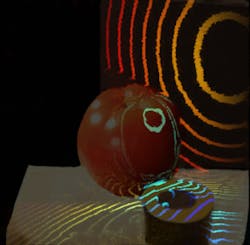HIGH-SPEED CAMERAS: Trillion fps visualizations image light in slow motion
Researchers at the Massachusetts Institute of Technology (MIT; Cambridge MA) Media Lab have developed a variety of streak camera that can be used to create trillion frame/s visualizations—slowing down and capturing even the motion of speed-of-light photons.1
For most high-speed time-of-flight and gated intensified CCD or ICCD imaging techniques used for light detection and ranging (lidar) and other ultrafast molecular imaging applications, the data revealed are typically depth-of-field or depth imaging data. The MIT Media Lab technique instead uses the two-dimensional (2D) narrow aperture of a streak camera to capture one-dimensional (1D) spatial information corresponding to the direction of the slit, and in the second dimension corresponding to the degree of deflection, to capture time information.
Ultrafast enablers
Enabled by ultrafast sources, detectors, and optical systems, the modified streak camera captures images that are used to reconstruct a full 2D movie at a resolution of 672 × 1000 pixels at a speed of about 0.5 × 1012 frames/s (2 ps time resolution).
A 795 nm, 600 mW ultrafast Ti:sapphire laser delivers 50 fs pulses at a repetition rate of 75 MHz to the scene. A small fraction of the beam is split off with a glass slide to synchronize the photodetector with the Hamamatsu C5680 streak camera, which has a time resolution of 512 samples over a 1 ns duration and a 1D field of view with a spatial resolution of 672 pixels.
Because the streak camera provides only the temporal evolution of a line in the scene (a 1D movie), a mirror system scans the field of view of the camera across the scene to capture a series of images—up to 1000 images over a two-hour period—to create a 2D movie since the laser and camera are synchronized.
“We call this ‘the world’s slowest fastest camera’ because it takes about an hour to collect all the data for a nanosecond-long video,” says MIT Media Lab associate professor Ramesh Raskar. “However, the camera enables the exploration of ultrafast phenomena such as the propagation of light in anisotropic media and photonic crystals, and could be used in materials-analysis applications to detect embedded defects or to analyze materials in a scene without entering the scene, for example.”
Trillion frame/s movies
Using the ultrafast trillion frame/s setup, one of the movies developed by the researchers shows a pulse of light as it transits a soda bottle filled with water (see http://youtu.be/EtsXgODHMWk), showing multibounce light transport and subsurface scattering.
In another video, a tomato and a roll of tape are imaged as a pulse of light energizes the scene (see figure and video at http://youtu.be/P-HqKjBgLPM). The pulse is reflected by a diffusely scattering surface on the right side of the scene to create a virtual light source, emerging as a spherical pulse front. As the pulse moves across the scene from left to right, some stray light first hits the tomato. After striking the diffuser, light floods the scene.
Indirectly illuminated parts of the scene (top of the tomato and inside the roll of tape) are not reached by the first direct wave of light, but only light up later as indirect light from the scattered wave reaches them. Shadows are visible after illumination, and the direct light that hits the back wall of the scene is reflected back toward the tomato and is trapped under the skin of the tomato due to subsurface scattering, where it glows for a while as the light fades.
REFERENCE
1. L. Hardesty, “Trillion-frame-per-second video,” MIT News Office, http://web.mit.edu/newsoffice/2011/trillion-fps-camera-1213.html (Dec. 13, 2011).
About the Author

Gail Overton
Senior Editor (2004-2020)
Gail has more than 30 years of engineering, marketing, product management, and editorial experience in the photonics and optical communications industry. Before joining the staff at Laser Focus World in 2004, she held many product management and product marketing roles in the fiber-optics industry, most notably at Hughes (El Segundo, CA), GTE Labs (Waltham, MA), Corning (Corning, NY), Photon Kinetics (Beaverton, OR), and Newport Corporation (Irvine, CA). During her marketing career, Gail published articles in WDM Solutions and Sensors magazine and traveled internationally to conduct product and sales training. Gail received her BS degree in physics, with an emphasis in optics, from San Diego State University in San Diego, CA in May 1986.
